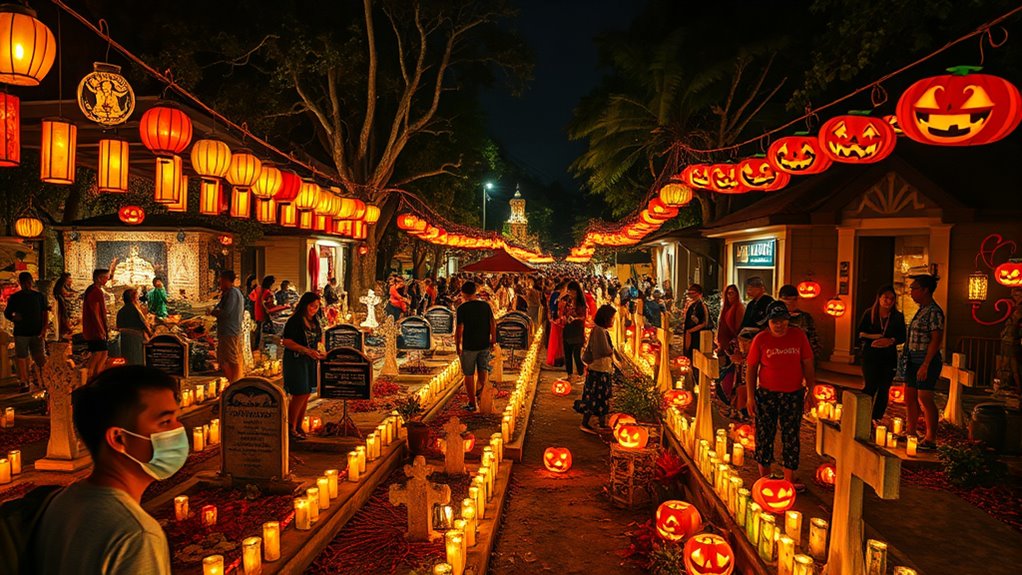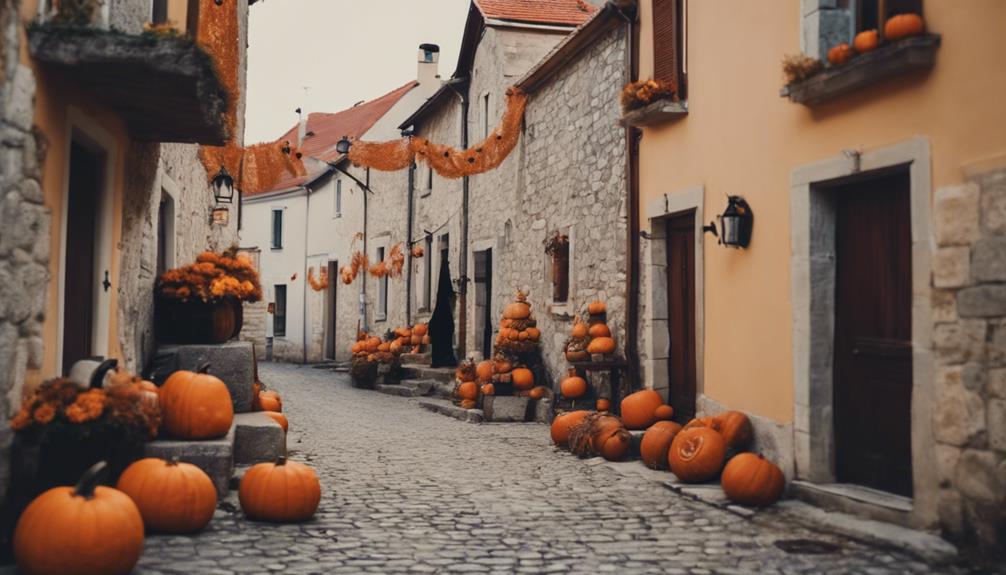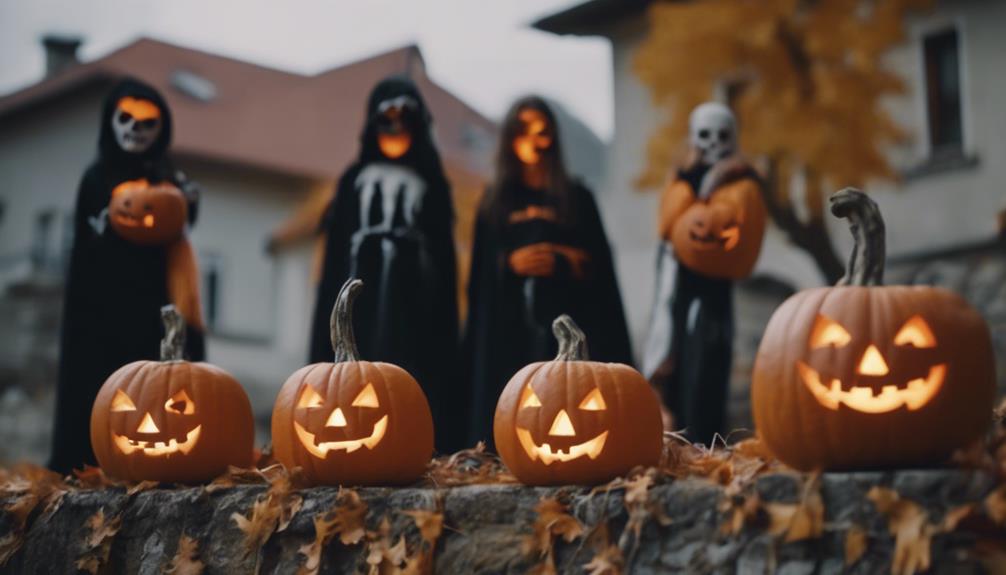In the Philippines, Undas and Halloween offer two contrasting ways to connect with community and tradition. Undas is a sacred, reflective celebration where families visit cemeteries, pray, and honor their ancestors with flowers and candles. Halloween, on the other hand, is lively and playful, featuring costumes, trick-or-treating, and neighborhood parties. Both festivities shape Filipino culture—if you want to discover how these unique celebrations coexist, keep exploring!
Key Takeaways
- Undas is a sacred Filipino tradition honoring ancestors with prayers and cemetery visits; Halloween is a festive, costume-driven celebration.
- Undas emphasizes spiritual remembrance and family reunions; Halloween focuses on community fun, costumes, and trick-or-treating.
- During Undas, cemeteries become reflective spaces with offerings and cleanups; Halloween features decorations, parties, and playful activities.
- Undas has deep cultural and religious significance rooted in Filipino Catholicism; Halloween blends Western influences with local festivities.
- Both celebrations foster community participation but serve different purposes—spiritual remembrance versus entertainment and creativity.

As October approaches in the Philippines, two distinct traditions—Undas and Halloween—take center stage, each reflecting different cultural roots and ways of honoring the dead. You’ll notice how these celebrations shape the country’s landscape, affecting everything from personal observances to community participation. Undas, also known as All Saints’ Day and All Souls’ Day, holds deep cultural importance rooted in Filipino Catholic traditions. It’s a time when families come together to visit cemeteries, clean tombs, and offer prayers, flowers, and candles for their departed loved ones. This practice isn’t just about remembering; it’s about reconnecting with ancestors and honoring their memory in a meaningful way. Many Filipinos see it as a sacred obligation, a way to keep alive their family history and spiritual ties. Community participation is crucial during Undas because it transforms cemeteries into bustling centers of activity. Local authorities often organize cleanup drives and safety measures, but it’s the families who truly bring the event to life. You might find entire neighborhoods working together to decorate graves or prepare food offerings, creating a sense of unity and shared purpose. The atmosphere is reflective and respectful, yet also lively with singing, prayer, and communal gatherings. People travel from far and wide, sometimes even from abroad, to pay their respects during this time, emphasizing its importance on a cultural level.
In contrast, Halloween’s roots are more global, influenced by Western customs, but it’s also embraced with a uniquely Filipino twist. While it’s often seen as a fun, spooky celebration with costumes, parties, and trick-or-treating, it’s increasingly integrated into local culture. You’ll notice children and adults alike donning costumes of ghosts, superheroes, and monsters, engaging in lively festivities that foster community participation. Halloween’s cultural importance lies in its ability to unite people through shared entertainment, creativity, and a bit of playful spookiness. Unlike Undas, which is solemn and reflective, Halloween is more about letting loose and expressing individuality. It also offers opportunities for community bonding, especially during neighborhood parties and school events, where everyone, young and old, participate in decorating, costume contests, and games. While it may not have the same spiritual weight as Undas, Halloween serves as a cultural bridge—blending Filipino hospitality with global influences and creating a festive atmosphere that encourages community interaction and fun. Both celebrations, though different in tone and origin, profoundly impact community participation and cultural expression in the Philippines during October.
Frequently Asked Questions
How Do Families Prepare for Undas and Halloween Celebrations?
You prepare for Undas and Halloween by planning your costume choices and decorative arrangements. For Undas, you visit cemeteries, bringing flowers and lighting candles to honor loved ones. For Halloween, you choose fun or spooky costumes and decorate your home with pumpkins, cobwebs, and lights. You might also organize themed parties or trick-or-treating activities, creating a festive atmosphere that celebrates both remembrance and spooky fun.
What Are the Traditional Foods Associated With Undas and Halloween?
Did you know that during Undas and Halloween, families enjoy unique traditional foods? You’ll find festive treats like rice cakes, sweet candies, and special traditional snacks that celebrate the occasion. These foods help create a warm, communal atmosphere. Whether it’s sticky rice desserts or spooky-themed candies, these traditional snacks make the celebration more meaningful and fun, bringing everyone together to honor loved ones or enjoy the spooky festivities.
Are There Any Regional Differences in How Undas and Halloween Are Celebrated?
You’ll notice regional customs and cultural variations shape how Undas and Halloween are celebrated. In some areas, Undas involves visiting family graves, offering prayers, and lighting candles, reflecting local traditions. Halloween might include costume parties and trick-or-treating, but customs differ across regions. These variations highlight how local beliefs and practices influence celebrations, making each area’s observance unique and vibrant within the broader cultural context of these festivities.
How Do Local Communities Organize Public Events for Both Occasions?
You can see communities organizing public events for both occasions through lively activities like community altar setups and costume contests. During Undas, locals gather to honor loved ones with decorated altars at cemeteries, while Halloween features costume contests, parades, and trick-or-treating. These events foster community spirit, allowing residents to participate actively, whether paying respects or celebrating with fun costumes and festivities, creating a vibrant, shared cultural experience.
What Safety Tips Are Recommended for Celebrating Undas and Halloween?
Imagine you’re celebrating Undas or Halloween with friends. To stay safe, follow cemetery etiquette—avoid loud noises and respect the surroundings. For costume safety, choose visible, non-restrictive outfits and avoid sharp accessories. Keep an eye on your kids, stay in well-lit areas, and carry a flashlight if needed. These simple tips help make sure everyone enjoys the festivities while staying safe and respectful of traditions.
Conclusion
As you navigate the shadows of Undas and Halloween, remember that both serve as mirrors reflecting your own journey through life and death. Like the silent vigil of ancient spirits or the lively dance of modern revelers, these traditions remind you to honor the past while embracing the present. In this dance between remembrance and celebration, you find your place—an ongoing story written in the echoes of ancestors and the laughter of today.










